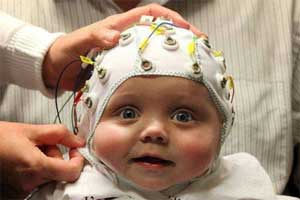- Home
- Editorial
- News
- Practice Guidelines
- Anesthesiology Guidelines
- Cancer Guidelines
- Cardiac Sciences Guidelines
- Critical Care Guidelines
- Dentistry Guidelines
- Dermatology Guidelines
- Diabetes and Endo Guidelines
- Diagnostics Guidelines
- ENT Guidelines
- Featured Practice Guidelines
- Gastroenterology Guidelines
- Geriatrics Guidelines
- Medicine Guidelines
- Nephrology Guidelines
- Neurosciences Guidelines
- Obs and Gynae Guidelines
- Ophthalmology Guidelines
- Orthopaedics Guidelines
- Paediatrics Guidelines
- Psychiatry Guidelines
- Pulmonology Guidelines
- Radiology Guidelines
- Surgery Guidelines
- Urology Guidelines
EEG Provide Early, Accurate Prediction of Autism in Infants

Autism spectrum disorder (ASD) can now be predicted in infants as young as 3 months with the help of inexpensive electroencephalograms (EEGs), according to a new study published in the journal Scientific Reports.
The study was conducted by Charles Nelson, PhD, director of the Laboratories of Cognitive Neuroscience at Boston Children's Hospital, and colleagues, to explore the utility of EEG for early detection of autism.
Autism spectrum disorder (ASD) is a complex neurological and developmental disorder which is diagnosed on the basis of behavioral symptoms during the second year of life or later. Finding scalable biomarkers for its early detection is challenging because of the variability in the presentation of the disorder. Hence, there arises a need for simple measurements that could be implemented routinely during well-baby checkups.
EEG is a relatively easy-to-use, low-cost brain measurement tool that is being increasingly explored as a potential clinical tool for monitoring the atypical development of the brain.
"EEGs are low-cost, non-invasive and relatively easy to incorporate into well-baby checkups," says Dr. Nelson. "Their reliability in predicting whether a child will develop autism raises the possibility of intervening very early, well before clear behavioral symptoms emerge. This could lead to better outcomes and perhaps even prevent some of the behaviors associated with ASD."
The study analyzed data from the Infant Sibling Project (now called the Infant Screening Project) that seeks to map early development and identify infants at risk for developing ASD and/or language and communication difficulties.
The Infant Screening Project provided Bosl with EEG data from 99 infants considered at high risk for ASD (having an older sibling with the diagnosis) and 89 low-risk controls (without an affected sibling). The EEGs were taken at 3, 6, 9, 12, 18, 24 and 36 months of age by fitting a net over the babies' scalps with 128 sensors as the babies sat in their mothers' laps. (An experimenter blew bubbles to distract them.) All babies also underwent extensive behavioral evaluations with the Autism Diagnostic Observation Schedule (ADOS), an established clinical diagnostic tool.
William Bosl, PhD, associate professor of Health Informatics and Clinical Psychology at the University of San Francisco, also affiliated with the Computational Health Informatics Program (CHIP) at Boston Children's Hospital, has been working for close to a decade on algorithms for interpretation of EEG signals, the familiar squiggly lines generated by electrical activity in the brain. Bosl's research suggests that even an EEG that appears normal contains "deep" data that reflect brain function, connectivity patterns, and structure that can be found only with computer algorithms.
Six different components (frequencies) of the EEG (high gamma, gamma, beta, alpha, theta, delta) were analyzed by Bosl's computational algorithms, using a variety of measures of signal complexity. These measures can reflect differences in how the brain is wired and how it processes and integrates information, says Bosl.
The algorithms predicted a clinical diagnosis of ASD with high specificity, sensitivity, and positive predictive value, exceeding 95 percent at some ages.
"The results were stunning," Bosl says. "Our predictive accuracy by 9 months of age was nearly 100 percent. We were also able to predict ASD severity, as indicated by the ADOS Calibrated Severity Score, with quite high reliability, also by 9 months of age."
Bosl believes that the early differences in signal complexity, drawing upon multiple aspects of brain activity, fit with the view that autism is a disorder that begins during the brain's early development but can take different trajectories. In other words, an early predisposition to autism may be influenced by other factors along the way.
"We believe that infants who have an older sibling with autism may carry a genetic liability for developing autism," says Nelson. "This increased risk, perhaps interacting with another genetic or environmental factor, leads some infants to develop autism -- although clearly not all, since we know that four of five "infant sibs" do not develop autism."
For further information click on the link: 10.1038/s41598-018-24318-x

Disclaimer: This site is primarily intended for healthcare professionals. Any content/information on this website does not replace the advice of medical and/or health professionals and should not be construed as medical/diagnostic advice/endorsement or prescription. Use of this site is subject to our terms of use, privacy policy, advertisement policy. © 2020 Minerva Medical Treatment Pvt Ltd